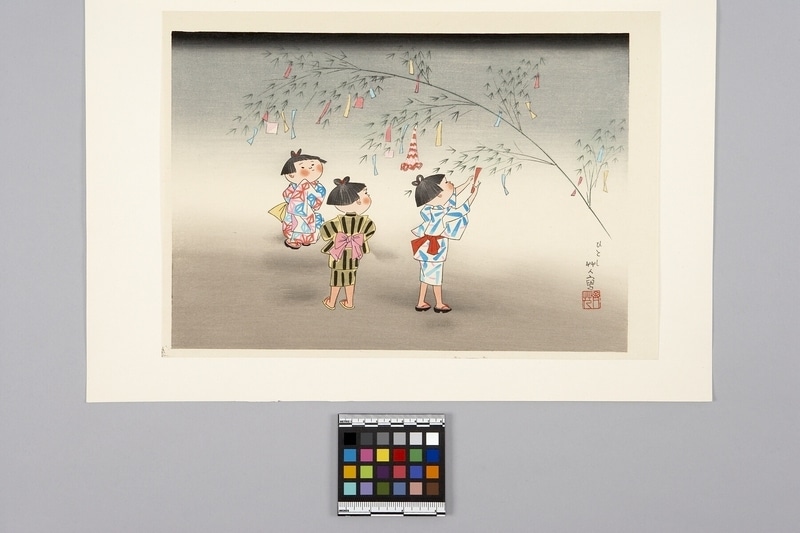Tanabata (Star festival) Item Number: 795/13 from the MOA: University of British Columbia

Description
A print showing three children on the left side tying tanzaku (短冊), small pieces of paper with wishes, on bamboo grass on the right side for Tanabata (七夕; star festival). The child furthest to the left and a little to the back is facing forward and is wearing yukata (浴衣; summer kimono) that has a pink, red, and light blue geometric pattern on a white background. The child in the middle has their head turned toward the right and is wearing yukata that has a vertical yellow and black striped pattern. The child to the right is tying a red tanzaku paper to the bamboo and is wearing yukata that has a pink and light blue pattern on a white background. The background from the top down is black, grey, beige, and brown. The artist’s signature in Japanese, ひとしin black, and his red square seal appear on the lower right corner. The print is horizontally rectangular.
Narrative
This print is by Kiyohara Hitoshi (清原斉; 1896 - 1956) and entitled Tanabata (七夕/たなばた; star festival). Tanabata literally means “the evening of the seventh”, and refers to the star festival, that derives from the Chinese Qixi festival. It celebrates the annual reunion of Orihime (織姫) and Hikoboshi (彦星) who are represented by the stars of Vegas and Altair in a legend. They are separated by the Milky Way and are allowed to meet only once a year on the seventh day of the seventh lunar month. The date varies from region to region, but is nowadays usually celebrated on July 7 of the Gregorian calendar. Kiyohara Hitoshi published several children’s picture books in the 1930s–1950s in addition to producing nihonga (日本画) or “Japanese style-paintings.”
Item History
- Made by Hitoshi Kiyohara (Maker) in Japan between 1950 and 1956
- Owned by Anne M. Smith before May 6, 1982
- Received from Anne M. Smith (Donor) on May 6, 1982
What
- Name
- Tanabata (Star festival)
- Identification Number
- 795/13
- Type of Item
- Overall
- height 33.2 cm, width 48.5 cm
- Image
- height 28.7 cm, width 33.5 cm
Who
- Culture
- Japanese
- Creator
- Hitoshi Kiyohara (Maker)
- Previous Owner
- Anne M. Smith
- Received from
- Anne M. Smith (Donor)
Where
- Holding Institution
- MOA: University of British Columbia
- Made in
- Japan
When
- Creation Date
- between 1950 and 1956
- Ownership Date
- before May 6, 1982
- Acquisition Date
- on May 6, 1982
Other
- Item Classes
- works on paper
- Condition
- good
- Accession Number
- 0795/0013